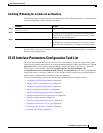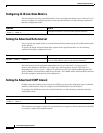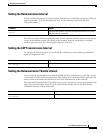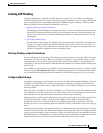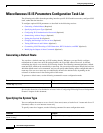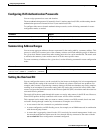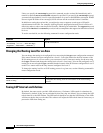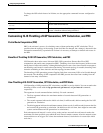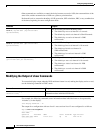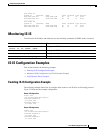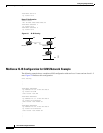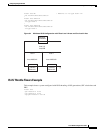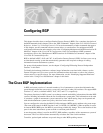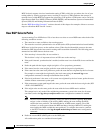
Configuring Integrated IS-IS
Miscellaneous IS-IS Parameters Configuration Task List
IPC-287
Cisco IOS IP Configuration Guide
To change the LSP refresh interval or lifetime, use the appropriate command in router configuration
mode:
Customizing IS-IS Throttling of LSP Generation, SPF Calculation, and PRC
Partial Route Computation (PRC)
PRC is the software’s process of calculating routes without performing an SPF calculation. This is
possible when the topology of the routing system itself has not changed, but a change is detected in the
information announced by a particular IS or when it is necessary to attempt to reinstall such routes in
the RIB.
Benefits of Throttling IS-IS LSP Generation, SPF Calculation, and PRC
IS-IS throttles three main events: link-state PDU (LSP) generation, Shortest Part First (SPF)
computation, and partial route computation (PRC). Throttling slows down the frequency of these events
during times of network instability. Although throttling these events slows down network convergence,
not throttling could result in a network not functioning. If network topology is unstable, throttling slows
down the scheduling of these intervals until the topology becomes stable.
The throttling of LSP generation prevents flapping links from cause many LSPs to be flooded through
the network. The throttling of SPF computation and PRC prevents the router from crashing from the
demand of too many calculations.
How Throttling of IS-IS LSP Generation, SPF Calculation, and PRC Works
IS-IS throttling of LSP generation, SPF calculations, and PRC occurs by default. You can customize the
throttling of these events with the lsp-gen-interval, spf-interval, and prc-interval commands,
respectively.
The arguments in each command behave similarly. For each command:
• The first argument indicates the maximum number of seconds between LSP generations or
calculations.
• The second argument indicates the initial wait time (in milliseconds) before running the first LSP
generation or calculation.
• The third argument indicates the minimum amount of time to wait (in milliseconds) between the first
and second LSP generation or calculation. (In addition to this wait time, there might be some other
system overhead between LSP generations or calculations.)
Each subsequent wait interval is twice as long as the previous one until the wait interval reaches the
maximum wait time specified, upon which the wait interval remains constant. After the network calms
down and there are no triggers for 2 times the maximum interval, fast behavior is restored (the initial
wait time).
Command Purpose
Router (config-router)# lsp-refresh-interval
seconds
Sets the LSP refresh interval.
Router (config-router)# max-lsp-lifetime
seconds
Sets the maximum time that link-state packets (LSPs) can remain in
a router’s database without being refreshed.



